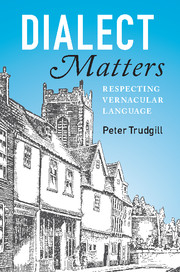Book contents
- Frontmatter
- Dedication
- Epigraph
- Contents
- Foreword
- Acknowledgements
- Map
- Themes
- 1 History: how things came to be this way
- 2 Prescriptivism and other useless pastimes
- 3 Language change: observing and accepting it
- 4 What is happening to words?
- 5 Languages and dialects in contact and conflict
- 6 Respecting English grammar
- 7 Respecting ordinary language
- 8 Sounds and fury
- 9 Respecting local speech
- 10 Grammar: the wonder of it all
- 11 More about words
- 12 Origins
- 13 Accent rules
- 14 Respecting names
- Postscript
- Index
1 - History: how things came to be this way
Published online by Cambridge University Press: 05 August 2016
- Frontmatter
- Dedication
- Epigraph
- Contents
- Foreword
- Acknowledgements
- Map
- Themes
- 1 History: how things came to be this way
- 2 Prescriptivism and other useless pastimes
- 3 Language change: observing and accepting it
- 4 What is happening to words?
- 5 Languages and dialects in contact and conflict
- 6 Respecting English grammar
- 7 Respecting ordinary language
- 8 Sounds and fury
- 9 Respecting local speech
- 10 Grammar: the wonder of it all
- 11 More about words
- 12 Origins
- 13 Accent rules
- 14 Respecting names
- Postscript
- Index
Summary
This section of the book is devoted to pieces which offer glimpses into the history of the English language: in Norwich, in Norfolk, in East Anglia and in Britain generally. The section starts, however, where English also started, on the European mainland; and the Prologue takes us even further back into our remote Eurasian Indo-European past.
Prologue: Sir William Jones and his revolution
About 230 years ago, Sir William Jones made an amazing intellectual breakthrough. He was a gifted learner of languages, and by an early age he had mastered Greek, Latin, Hebrew and Arabic. He had even translated Persian into French. In 1783, arriving in Calcutta where he had been appointed as a judge, he started learning Sanskrit, the ancient classical language of northern India – one of the first Britons to do so.
He was astonished by what he found. Could it just be a coincidence that the Latin word pater, Greek patér and Sanskrit pitár all meant ‘father’; and that Latin frater, Ancient Greek phrater and Sanskrit bhratar all meant ‘brother’? After all, Sanskrit had been spoken 3,500 miles from Italy, where Latin had been spoken. The similarities, however, were undeniable, especially in the grammar: for example, Latin est (‘it is’) was asti in Sanskrit, sumus (‘we are’) was smas, and sunt (‘they are’) was santi.
In a famous lecture, Jones argued there was “a stronger affinity” between Sanskrit, Latin and Greek “than could possibly have been produced by accident”. Others had also noticed this, but Jones’ breakthrough was to state that the affinity was so strong that no linguist could examine the three languages “without believing them to have sprung from some common source, which, perhaps, no longer exists”.
That was the big new idea: that there had been an earlier parent language which had since disappeared. Previously, scholars had misguidedly wondered which of the world's existing languages had been the “first” language – Hebrew was often mentioned.
- Type
- Chapter
- Information
- Dialect MattersRespecting Vernacular Language, pp. 1 - 24Publisher: Cambridge University PressPrint publication year: 2016



